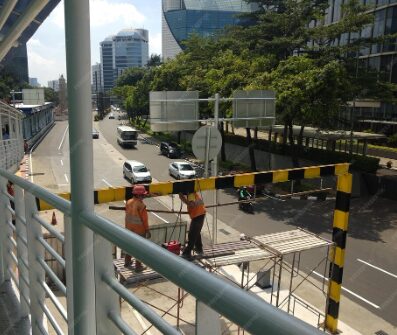The Surfaces That Carry the Weight of Cities
Every day, millions of people move across bridges, wait under overpasses, and walk past retaining walls. Few of them pause to consider the materials beneath their feet or the layers that protect those surfaces from wind, rain, vibration, and time. While structural design draws interest during the planning and building stages, the role of protection often receives less attention. Yet that protective layer—what engineers call the coating—often decides how long the structure lasts.
Infrastructure coatings serve as the interface between the built environment and the forces that wear it down. They guard concrete against moisture and freeze-thaw stress. They keep steel from rusting. They create barriers between corrosive chemicals and the structural materials beneath. Their job isn’t to shine or impress. It’s to hold fast, year after year, against everything that moves through and around a city.
A Function That Works in the Background
Unlike major repairs or new construction, coating work rarely draws public notice. Application often happens in overnight windows or during scheduled maintenance closures. Crews apply materials, monitor cure times, and test for uniform thickness. Once complete, the surface looks much like it did before. The change lies in its resistance—not its appearance.
Over time, that resistance reduces the need for costly interventions. It slows the cycle of damage. Cracks remain sealed. Rust does not take hold. Water does not penetrate. For city planners working within tight budgets, these benefits extend far beyond material cost. They reduce closures, limit emergency work, and keep infrastructure open when the surrounding systems depend on it.
A concrete tunnel or steel overpass may not seem vulnerable when freshly poured or welded. But exposure begins immediately. Salt from road treatment enters pores and expands during freeze-thaw cycles. UV light degrades untreated surfaces. Airborne chemicals settle. Without protection, even the strongest materials degrade.
Why Coatings Must Match Their Environment
Not every coating performs equally under all conditions. A coastal bridge must resist salt spray and humidity. A desert overpass faces temperature extremes. A wastewater tank requires protection against chemicals and constant moisture. These environments demand coatings tailored to their setting.
Selection begins with an understanding of both the material and the use case. A flexible coating may stretch without cracking but offer limited abrasion resistance. A rigid coating may seal tightly but fail when a structure shifts. Application method also matters. Some coatings must be sprayed in specific humidity ranges. Others require layered systems with primers, membranes, and top layers.
The most effective use of coatings comes when they form part of the original plan—not a repair added later. Integrating coatings during construction allows for better surface preparation, proper curing, and cleaner installation. Retrofitting remains possible and sometimes necessary, but it carries more risk, especially if the substrate already shows damage.
Polyurea and the Rise of Rapid-Set Solutions
In recent years, polyurea has gained attention for infrastructure use. This fast-set material, often applied as a spray, forms a seamless membrane that resists water, abrasion, and chemical exposure. Unlike older coatings, polyurea cures in seconds and bonds to a variety of substrates, including concrete and steel.
Its flexibility allows it to handle structural movement, while its strength makes it suitable for areas with high mechanical stress. These qualities have led to its use in everything from bridge decks to containment areas.
One of the leading providers in this space, ArmorThane, has worked with municipalities to deliver tailored coating systems for real-world conditions. Their work in infrastructure coatings focuses on long-term performance and compatibility with complex environments. By aligning material science with field requirements, they support a more proactive form of maintenance.
Why Maintenance Must Include Protection
The discussion around infrastructure often centers on repair. News stories show cracks in beams, spalling concrete, or closed lanes due to structural wear. But by the time damage becomes visible, the system already faces deeper issues. The better question is not when to fix, but how to protect.
Including coatings in maintenance planning shifts the timeline forward. Instead of waiting for failure, engineers treat surfaces before stress accumulates. This change doesn’t eliminate repair needs, but it changes the scale. Surfaces wear evenly. Inspections show fewer surprises. Emergencies become less common.
Cities that prioritize coating maintenance often spend less over time, not more. They also build public trust, as closures happen less frequently and major failures grow rarer.
The Real Role of Infrastructure Coatings
Infrastructure coatings don’t draw the eye. They don’t appear in renderings. They carry no celebratory ribbon cuttings. Yet they play a central role in how the built world remains reliable.
Their value grows with time. A project that includes coating work may look no different from one that doesn’t. But a decade later, the difference appears in the maintenance logs, in the closed-lane reports that never came, and in the budget sheets that stay under control.
They remind us that protection does not require noise. It requires planning, precision, and respect for the slow work of time. Cities that understand this principle—cities that coat before they patch—will build systems that stay strong not because they resist change, but because they prepare for it.



































